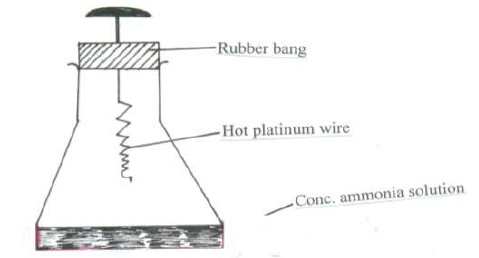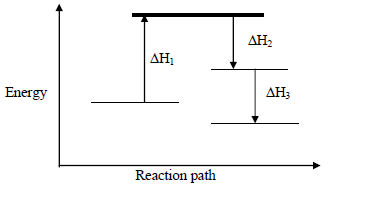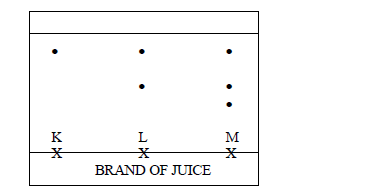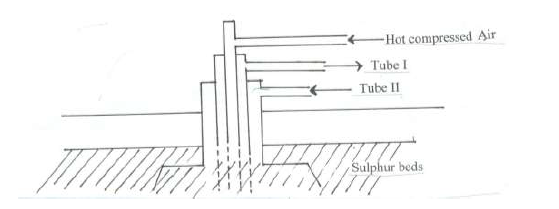
There are very few suitable low melting point salts. Lead bromide has a low melting point
and makes an interesting electrolysis experiment. Potassium bromide may have too high a
melting point, 682oC, to melt easily. The lead bromide is melted in a 100 mL hard glass
beaker, or in a crucible. The carbon electrodes are supported by a strip of wood with two
holes bored 2 cm apart for the electrodes. Connect crocodile clips to the rods and complete
the circuit with a torch bulb, to indicate when a current is flowing, and a 12-volt torch
battery or cells wired in series. The electrodes can be labelled positive and negative. The
only ions present in this melt are the bromide and lead ions. Bromine is readily seen coming
off at the positive electrode, which is the anode. The fact that bromine appears only at the
positive electrode helps in the understanding of the existence of a negative bromide ion.
Lead has both a lower melting point and a greater density than lead bromide and therefore
appears as a melt at the bottom of the beaker. The small globule of lead, which accumulates
at the negative electrode, the cathode, can be seen after about 10 minutes of electrolysis.
Decant off the molten lead bromide carefully into another crucible. The electric current
has split up crystalline lead bromide into bromine gas and lead metal.
sharon kalunda answered the question on April 12, 2019 at 08:24
-
Describe an experiment to estimate the size of an oil molecule.
(Solved)
Describe an experiment to estimate the size of an oil molecule.
Date posted:
April 12, 2019
.
Answers (1)
-
Describe how Oxygen gas is prepared,collected and tested in the laboratory.
(Solved)
Describe how Oxygen gas is prepared,collected and tested in the laboratory.
Date posted:
April 12, 2019
.
Answers (1)
-
Using a solid naphthalene as an example,describe how impurities affects the melting point of a substance.
(Solved)
Using a solid naphthalene as an example,describe how impurities affects the melting point of a substance.
Date posted:
April 12, 2019
.
Answers (1)
-
Explain how a burette is used.
(Solved)
Explain how a burette is used.
Date posted:
April 12, 2019
.
Answers (1)
-
Draw and name the apparatus used in the laboratory.
(Solved)
Draw and name the apparatus used in the laboratory.
Date posted:
April 12, 2019
.
Answers (1)
-
Describe an experiment to demonstrate the purity of water using boiling point.
(Solved)
Describe an experiment to demonstrate the purity of water using boiling point.
Date posted:
April 11, 2019
.
Answers (1)
-
State three examples of allotropes of carbon
(Solved)
State three examples of allotropes of carbon.
Date posted:
April 9, 2019
.
Answers (1)
-
Define the following terms as used in chemistry: atom,molecule, element and compound
(Solved)
Define the following terms as used in chemistry: atom,molecule, element and compound
Date posted:
April 9, 2019
.
Answers (1)
-
Describe how the mixture of sugar, iodine and lead (II) carbonate can be separated
(Solved)
Describe how the mixture of sugar, iodine and lead (II) carbonate can be separated.
Date posted:
April 9, 2019
.
Answers (1)
-
The diagram below shows an investigation on a property of ammonia gas.
(Solved)
The diagram below shows an investigation on a property of ammonia gas.

(a) The platinum wire is observed to glow. Explain the cause of that observation.
(b) State the observations made when the rubber bang is removed.
Date posted:
April 1, 2019
.
Answers (1)
-
The molar masses of gases W and X are 16.0 and 44.0 respectively. If the rate of diffusion of W through porous material is 12cm3s-1....
(Solved)
The molar masses of gases W and X are 16.0 and 44.0 respectively. If the rate of diffusion of W through porous material is 12cm3s-1. Calculate the rate of diffusion of X through the same material.
Date posted:
April 1, 2019
.
Answers (1)
-
The lattice energy of sodium bromide and hydration energies of sodium and bromide ions are:- 733, 406 and 335kJ/mol respectively.
(Solved)
The lattice energy of sodium bromide and hydration energies of sodium and bromide ions are:- 733, 406 and 335kJ/mol respectively.
(i) Complete the energy cycle diagram below by inserting the values of changeH1, changeH2 and changeH3.

(ii) Determine the molar heat of solution of solid sodium bromide.
Date posted:
April 1, 2019
.
Answers (1)
-
Using dots (.) and crosses (x), show bonding in:-Sodium oxide (Na = 11; O = 8 )
(Solved)
Using dots (.) and crosses (x), show bonding in:-Sodium oxide (Na = 11; O = 8 )
Date posted:
April 1, 2019
.
Answers (1)
-
Using dots (.) and crosses (x), show bonding in:The compound formed when nitrogen reacts with fluorine. (F = 9, N = 7)
(Solved)
Using dots (.) and crosses (x), show bonding in:The compound formed when nitrogen reacts with fluorine. (F = 9, N = 7)
Date posted:
April 1, 2019
.
Answers (1)
-
20.0cm3 of a solution containing 4gm per litre of sodium hydroxide was neutralized by
8.0cm3 of dilute sulphuric acid. Calculate the concentration of sulphuric acid in...
(Solved)
20.0cm3 of a solution containing 4gm per litre of sodium hydroxide was neutralized by
8.0cm3 of dilute sulphuric acid. Calculate the concentration of sulphuric acid in moles per litre.( Na = 23.0; O = 16.0; H = 1.0 )
Date posted:
April 1, 2019
.
Answers (1)
-
The diagram below represents a paper chromatogram for three brands of juices suspected to contain banned food colourings by the Kenya Bureau of Standards.
(Solved)
The diagram below represents a paper chromatogram for three brands of juices suspected to contain banned food colourings by the Kenya Bureau of Standards.

The results showed the presence of banned food colourings in L and M only. On the same diagram
(a) Circle the spots which show the banned food colourings.
(b) Show the solvent front.
(c ) Name one possible solvent that can be used in this experiment / research.
Date posted:
April 1, 2019
.
Answers (1)
-
The diagram below represents the extraction of sulphur by frasch process in Louisiana U.S.A.
(Solved)
The diagram below represents the extraction of sulphur by frasch process in Louisiana U.S.A.

(a) Name the substance that passes through tube:-
I
II
(b) What is the purpose of hot compressed air in this process ?
Date posted:
April 1, 2019
.
Answers (1)
-
Give the differences between esterification and neutralisation.
(Solved)
Give the differences between esterification and neutralisation.
Date posted:
April 1, 2019
.
Answers (1)
-
The table below gives elements represented by letters U V W X Y Z and their atomic numbers.
(Solved)
The table below gives elements represented by letters U V W X Y Z and their atomic numbers.

Use the information to answer the questions below.
(a) In which period do these elements belong ? Give a reason.
(b) How does the atomic radius of W and Y compare ? Explain.
(c ) Give the formula of the compound that could be formed between V and X.
(d) What type of bonding will be present in a compound formed between V and Z. Explain.
(e) Arrange the species U, U- and U+ in increasing order of size.
(f) Which of the ions Y2+ and Y2- is the most stable ? Explain.
(g) Give the formula of
(i) An acidic oxide formed when one of the elements in the table is heated in air.
(ii) A basic oxide formed when one of the elements in the table is heated in air.
Date posted:
April 1, 2019
.
Answers (1)
-
57.2g of hydrated sodium carbonate (Na2CO3.XH2O) were dissolved in water and the solution made to one litre. 20cm3 of 0.5M HCl recated with 25cm3 of...
(Solved)
57.2g of hydrated sodium carbonate (Na2CO3.XH2O) were dissolved in water and the solution made to one litre. 20cm3 of 0.5M HCl recated with 25cm3 of the hydrated sodium carbonate solution. Determine the value of X. (Na = 23, C = 12, O = 16)
Date posted:
April 1, 2019
.
Answers (1)